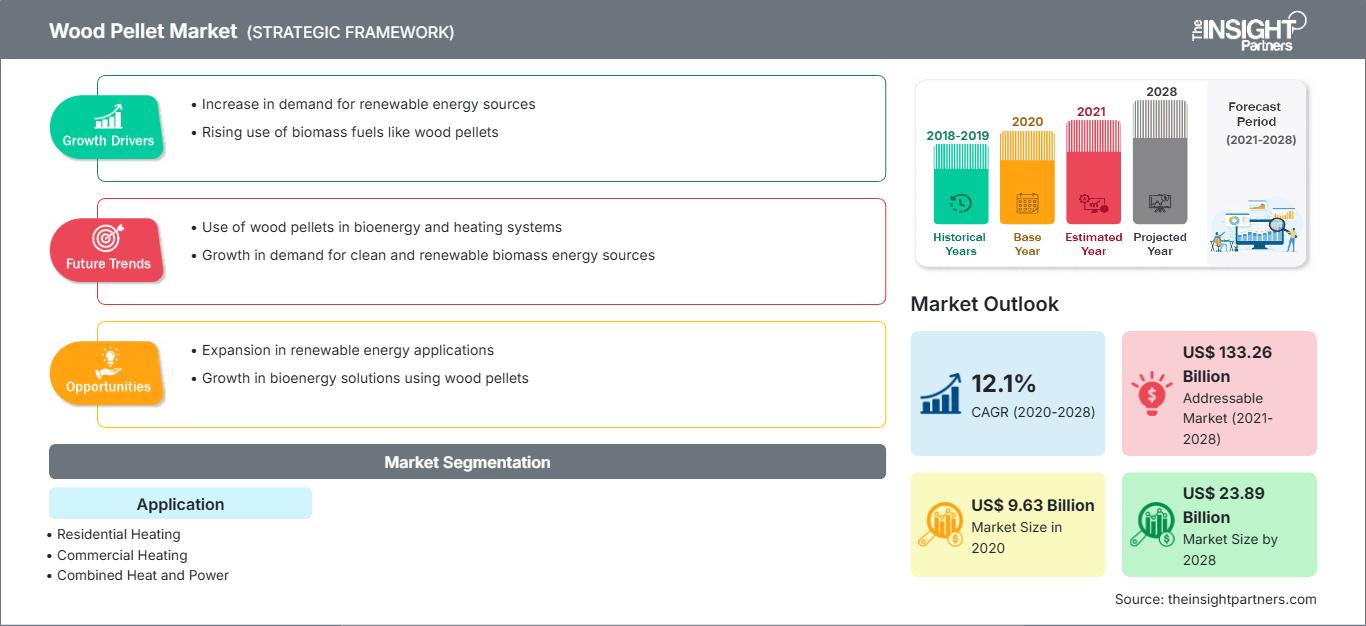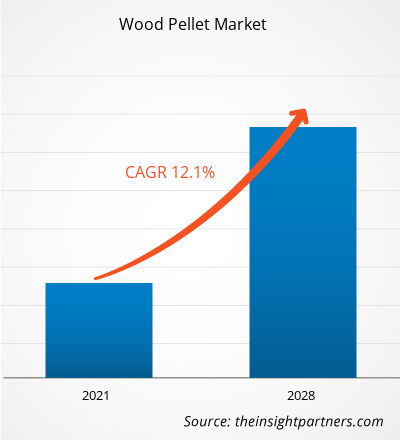El mercado de pellets de madera se valoró en US$ 9.630,99 millones en 2020 y se proyecta que alcance los US$ 23.892,77 millones para 2028; se espera que crezca a una CAGR del 12,1% de 2021 a 2028.
Los pellets de madera se producen a partir de corteza de madera finamente molida y se utilizan principalmente como combustible. Se emplean ampliamente en viviendas para una combustión eficiente en estufas pequeñas. Se producen a partir de numerosos residuos de madera y se consideran una fuente de energía renovable. Actualmente, junto con la calefacción residencial, el uso de pellets de madera para la generación de energía está aumentando en todo el mundo. Su uso como combustible es generalizado a nivel mundial, lo que se prevé que aumente la demanda de pellets de madera en los próximos años. Europa es la principal región en consumo de pellets de madera para la generación de energía. Además, América del Norte es un importante exportador de pellets de madera, lo que se prevé que aumente la capacidad de producción en los próximos años.
En 2020, Europa contribuyó con la mayor participación en el mercado global. Un informe anual presentado ante la Red Global de Información Agrícola del Servicio Agrícola Exterior del USDA indica que el mercado de pellets de madera en Europa se ha visto relativamente poco afectado por la pandemia de COVID-19. Según el informe, la región consumió aproximadamente 29 millones de toneladas métricas de pellets de madera en 2018, lo que la convierte en el mayor mercado de pellets del mundo. Los pellets de madera se utilizan en aplicaciones residenciales para calefacción y generación de calor y energía industrial. El informe también indica que la región contribuye actualmente con aproximadamente el 30% de la producción mundial de pellets. Sin embargo, representa el mayor consumo de pellets de madera a nivel mundial. Italia, Alemania y otros países similares se consideran los principales mercados en crecimiento para el consumo de pellets de madera en aplicaciones de calefacción residencial. El Reino Unido es uno de los principales consumidores de pellets de madera, seguido de Italia y Dinamarca.
El mercado mundial de pellets de madera se ha enfrentado a numerosos desafíos a raíz del brote de COVID-19. La pandemia ha alterado drásticamente el panorama del sector químico y de materiales, impactando negativamente el crecimiento de este mercado. La implementación de medidas para combatir la propagación del virus ha agravado la situación y afectado el crecimiento de diversos sectores industriales. El mercado se ha visto afectado por la repentina distorsión en la eficiencia operativa y las interrupciones en las cadenas de valor, atribuibles al cierre repentino de fronteras nacionales e internacionales. Las interrupciones en el suministro de materias primas y el cierre temporal de plantas de producción debido a confinamientos indefinidos y cuarentenas temporales han impactado el crecimiento del mercado durante la pandemia. Según una noticia publicada por Woodcote Media Ltd el 30 de julio de 2020, una encuesta realizada por ENplus, un sistema de certificación de pellets de madera, reveló que el 75% de los productores certificados se han visto afectados negativamente por la pandemia de COVID-19. Las empresas planean revisar los precios de los pellets de madera para los consumidores finales. Sin embargo, el mismo informe indicó que aproximadamente el 5% de los encuestados cree que hay un ligero aumento en la demanda de pellets de madera por parte de los usuarios finales. Asimismo, la cadena de suministro de madera se ha visto afectada por la pandemia, lo que ha provocado interrupciones en el suministro y los precios de las materias primas.
Obtendrá personalización en cualquier informe, sin cargo, incluidas partes de este informe o análisis a nivel de país, paquete de datos de Excel, así como también grandes ofertas y descuentos para empresas emergentes y universidades.
Mercado de pellets de madera: Perspectivas estratégicas

- Obtenga las principales tendencias clave del mercado de este informe.Esta muestra GRATUITA incluirá análisis de datos, que abarcarán desde tendencias de mercado hasta estimaciones y pronósticos.
Perspectivas del mercado
Mayor concienciación sobre el uso de fuentes de energía renovables
Las energías renovables desempeñan un papel fundamental para satisfacer las futuras necesidades energéticas tanto en zonas rurales como urbanas. La escasez de recursos, junto con una mayor concienciación sobre los impactos ambientales negativos de los productos y procesos basados en combustibles fósiles, ha impulsado la dependencia de fuentes de energía renovables como los pellets de madera. La creciente necesidad de un desarrollo energético sostenible es otro factor que contribuye al aumento de la demanda de pellets de madera. Los recursos y tecnologías de energías renovables se consideran alternativas respetuosas con el medio ambiente, ya que, en general, causan un impacto ambiental limitado o nulo en comparación con otras formas de energía. Además, estos recursos son fácilmente accesibles e inagotables.
Los pellets de madera se clasifican como fuentes de energía renovables, ya que provienen de árboles y son una forma de biomasa. Están compuestos de fibras de madera secas y comprimidas, preparadas a partir de residuos de aserraderos, desechos forestales (como pilas de restos de árboles) y troncos enteros. Según la Administración de Información Energética de Estados Unidos, la biomasa se define como un material orgánico que puede utilizarse eficazmente como fuente de energía. Varias formas de biomasa, como los pellets de madera, son neutras en carbono y su combustión no genera emisiones netas de carbono.
Información sobre tipos
Según su aplicación, el mercado mundial de pellets de madera se segmenta en calefacción residencial, calefacción comercial, cogeneración (calor y electricidad combinados) y generación de energía. El segmento de calefacción residencial lideró el mercado mundial de pellets de madera en 2020. Los sistemas de calefacción a base de madera se utilizan comúnmente en todo el mundo para la calefacción residencial, y recientemente los pellets de madera han estado reemplazando a la leña tradicional. Las calderas de pellets de madera para calefacción residencial prometen bajas emisiones, alta eficiencia y funcionamiento automático. Los pellets de madera se utilizan para la calefacción residencial en estufas de pellets. También se utilizan en calderas de pellets para generar calor, vapor y electricidad en el sector servicios, la generación de energía y la industria manufacturera. Su uso para la generación de energía y calor en los sectores manufacturero y energético impulsa el mercado de pellets de madera. Dado que el costo de los pellets de madera se ha mantenido más bajo que el de otros combustibles durante mucho tiempo, se ha convertido en una opción más económica, respondiendo a la principal preocupación del sector residencial. Como fuente de energía renovable, los pellets de madera han recibido incentivos y subsidios de los gobiernos de varios países. En los últimos años, muchos países han implementado o actualizado sus políticas y programas relacionados con los pellets de madera para calefacción.
Entre los principales actores del mercado de pellets de madera se encuentran Pacific BioEnergy, Premium Pellet Ltd., Pinnacle Renewable Energy, Enviva, ANDRITZ, Wood & Sons, Graanul Invest, New England Wood Pellet, TANAC y Energex Pellet Fuel, Inc.
Informe destacado
- Tendencias progresivas de la industria en el mercado mundial de pellets de madera para ayudar a los participantes a desarrollar estrategias efectivas a largo plazo.
- Estrategias de crecimiento empresarial adoptadas por los mercados desarrollados y en desarrollo
- Análisis cuantitativo del mercado mundial de pellets de madera de 2019 a 2028
- Estimación de la demanda del mercado de pellets de madera en diversos sectores
- Análisis PEST para ilustrar la eficacia de los compradores y proveedores que operan en la industria para predecir el crecimiento del mercado
- Últimos avances para comprender el panorama competitivo del mercado y la demanda de pellets de madera.
- Tendencias y perspectivas del mercado, junto con los factores que impulsan y restringen el crecimiento del mercado de pellets de madera.
- Proceso de toma de decisiones mediante la comprensión de las estrategias que sustentan el interés comercial con respecto al crecimiento del mercado mundial de pellets de madera.
- Tamaño del mercado de pellets de madera en varios nodos del mercado
- Descripción detallada y segmentación del mercado mundial de pellets de madera, así como su dinámica en la industria.
- Tamaño del mercado de pellets de madera en varias regiones con prometedoras oportunidades de crecimiento
Perspectivas regionales del mercado de pellets de madera
Los analistas de The Insight Partners han explicado en detalle las tendencias regionales y los factores que influyen en el mercado de pellets de madera durante el período de previsión. Esta sección también analiza los segmentos del mercado de pellets de madera y su distribución geográfica en Norteamérica, Europa, Asia Pacífico, Oriente Medio y África, y Sudamérica y Centroamérica.
Alcance del informe de mercado de pellets de madera
| Atributo del informe | Detalles |
|---|---|
| Tamaño del mercado en 2020 | US$ 9.63 mil millones |
| Tamaño del mercado en 2028 | US$ 23.89 mil millones |
| Tasa de crecimiento anual compuesto global (2020 - 2028) | 12,1% |
| Datos históricos | 2018-2019 |
| período de previsión | 2021-2028 |
| Segmentos cubiertos | Por aplicación
|
| Regiones y países cubiertos | América del norte
|
| Líderes del mercado y perfiles de empresas clave |
|
Densidad de actores del mercado de pellets de madera: comprensión de su impacto en la dinámica empresarial
El mercado de pellets de madera está creciendo rápidamente, impulsado por la creciente demanda de los usuarios finales debido a factores como la evolución de las preferencias de los consumidores, los avances tecnológicos y una mayor conciencia de los beneficios del producto. A medida que aumenta la demanda, las empresas amplían su oferta, innovan para satisfacer las necesidades de los consumidores y aprovechan las nuevas tendencias, lo que impulsa aún más el crecimiento del mercado.

- Obtenga una descripción general de los principales actores clave del mercado de pellets de madera
El informe segmenta el mercado mundial de pellets de madera de la siguiente manera:
Mercado de pellets de madera, por aplicación
- Por aplicación, el mercado global de pellets de madera está segmentado en calefacción residencial, calefacción comercial, calor y energía combinados (CHP) y generación de energía.
Perfiles de empresas
- Bioenergía del Pacífico
- Pellet Premium Ltd.
- Pinnacle Energía Renovable
- Enviva
- ANDRITZ
- Madera e hijos
- Graanul Invest
- Pellets de madera de Nueva Inglaterra v5/8520
- TANAC
- Combustible de pellets Energex, Inc.
- Análisis histórico (2 años), año base, pronóstico (7 años) con CAGR
- Análisis PEST y FODA
- Tamaño del mercado, valor/volumen: global, regional y nacional
- Industria y panorama competitivo
- Conjunto de datos de Excel
Informes recientes
Informes relacionados
Testimonios
Razón para comprar
- Toma de decisiones informada
- Comprensión de la dinámica del mercado
- Análisis competitivo
- Información sobre clientes
- Pronósticos del mercado
- Mitigación de riesgos
- Planificación estratégica
- Justificación de la inversión
- Identificación de mercados emergentes
- Mejora de las estrategias de marketing
- Impulso de la eficiencia operativa
- Alineación con las tendencias regulatorias




















 Obtenga una muestra gratuita para - Mercado de pellets de madera
Obtenga una muestra gratuita para - Mercado de pellets de madera